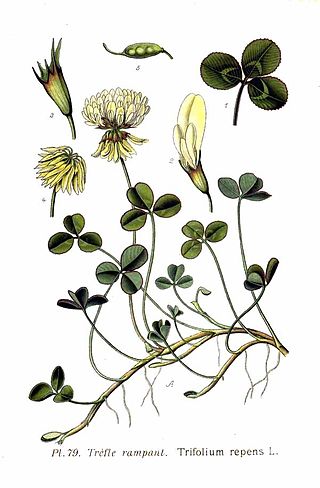
Clover, also called trefoil, are plants of the genus Trifolium, consisting of about 300 species of flowering plants in the legume family Fabaceae originating in Europe. The genus has a cosmopolitan distribution with highest diversity in the temperate Northern Hemisphere, but many species also occur in South America and Africa, including at high altitudes on mountains in the tropics. They are small annual, biennial, or short-lived perennial herbaceous plants, typically growing up to 30 centimetres (12 in) tall. The leaves are trifoliate, with stipules adnate to the leaf-stalk, and heads or dense spikes of small red, purple, white, or yellow flowers; the small, few-seeded pods are enclosed in the calyx. Other closely related genera often called clovers include Melilotus and Medicago.

Medicago is a genus of flowering plants, commonly known as medick or burclover, in the legume family (Fabaceae). It contains at least 87 species and is distributed mainly around the Mediterranean Basin, and extending across temperate Eurasia and sub-Saharan Africa. The best-known member of the genus is alfalfa, an important forage crop, and the genus name is based on the Latin name for that plant, medica, from Greek: μηδική (πόα) Median (grass). Most members of the genus are low, creeping herbs, resembling clover, but with burs. However, alfalfa grows to a height of 1 meter, and tree medick is a shrub. Members of the genus are known to produce bioactive compounds such as medicarpin and medicagenic acid. Chromosome numbers in Medicago range from 2n = 14 to 48.

Dianthus caryophyllus, commonly known as carnation or clove pink, is a species of Dianthus native to the Mediterranean region. Its exact natural range is uncertain due to extensive cultivation over the last 2,000 years. Carnations are prized for their vibrant colors, delicate fringed petals, and enchanting fragrance.
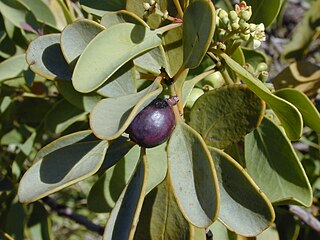
The Santalaceae, sandalwoods, are a widely distributed family of flowering plants which, like other members of Santalales, are partially parasitic on other plants. Its flowers are bisexual or, by abortion, unisexual. Modern treatments of the Santalaceae include the family Viscaceae (mistletoes), previously considered distinct.

Lathyrus is a genus of flowering plants in the legume family Fabaceae, and contains approximately 160 species. Commonly known as peavines or vetchlings, they are native to temperate areas, with a breakdown of 52 species in Europe, 30 species in North America, 78 in Asia, 24 in tropical East Africa, and 24 in temperate South America. There are annual and perennial species which may be climbing or bushy. This genus has numerous sections, including Orobus, which was once a separate genus. The genus has numerous synonyms, including Pisum, the ancient Latin name for the pea.

Dianthus is a genus of about 340 species of flowering plants in the family Caryophyllaceae, native mainly to Europe and Asia, with a few species in north Africa and in southern Africa, and one species in arctic North America. Common names include carnation, pink and sweet william.
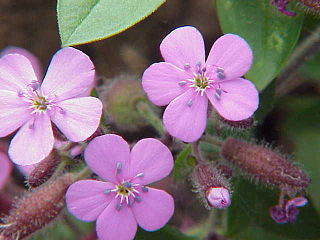
Saponaria is a genus of flowering plants in the family Caryophyllaceae, native to Asia and Europe, and are commonly known as soapworts. They are herbaceous perennials and annuals, some with woody bases. The flowers are abundant, five-petalled and usually in shades of pink or white. The genus is closely related to the genus Silene, being distinguished from these by having only two styles in the flower. It is also related to Gypsophila, but its calyx is cylindrical rather than bell-shaped.

Dianthus barbatus, the sweet William, is a species of flowering plant in the family Caryophyllaceae, native to southern Europe and parts of Asia. It has become a popular ornamental garden plant. It is a herbaceous biennial or short-lived perennial plant growing to 13–92 cm tall, with flowers in a dense cluster of up to 30 at the top of the stems. Each flower is 2–3 cm diameter with five petals displaying serrated edges. Wild plants produce red flowers with a white base, but colours in cultivars range from white, pink, red, and purple to variegated patterns. The exact origin of its English common name is unknown but first appears in 1596 in botanist John Gerard's garden catalogue. The flowers are edible and may have medicinal properties. Sweet William attracts bees, birds, and butterflies.

Dianthus deltoides, the maiden pink, is a species of Dianthus native to most of Europe and western Asia. It can also be found in many parts of North America, where it is an introduced species.

Dianthus armeria, the Deptford pink or grass pink, is a species of Dianthus ("pink") native to most of Europe, from Portugal north to southern Scotland and southern Finland, and east to Ukraine and the Caucasus. It is naturalised in North America.
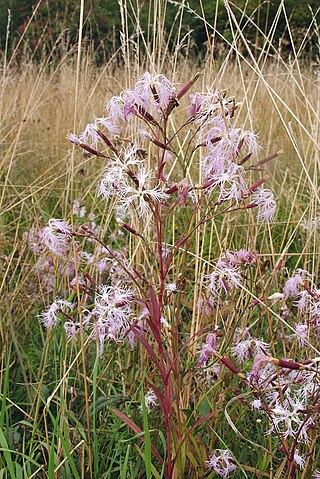
Dianthus superbus, the fringed pink or large pink, is a species of Dianthus native to Europe and northern Asia, from France north to arctic Norway, and east to Japan; in the south of its range, it occurs at high altitudes, up to 2,400 m.

Sisymbrium is a genus of plants in the family Brassicaceae.
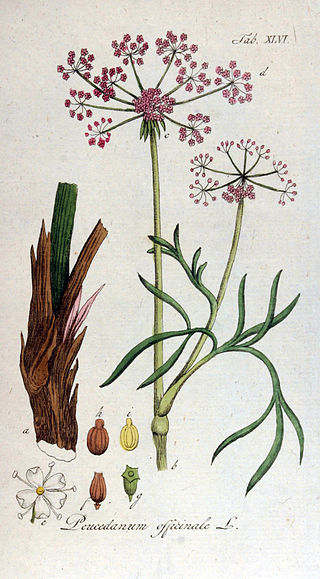
Peucedanum is a genus of flowering plant in the carrot family, Apiaceae. Peucedanum boasts a global presence with diverse spread of morphological features. Peucedanum species are characterized by dorsally compressed mericarps, slightly prominent dorsal ribs, narrowly winged lateral ribs, and a broad commissure. However, the vast diversity of morphology, fruit forms, and phytochemical production makes classifying species in the Peucedanum challenging. Historically relevant in traditional medicine, Peucedanum's taxonomic complexity arises from its extensive diversity.

Melaleuca linearis, commonly known as narrow-leaved bottlebrush, is a plant in the myrtle family, Myrtaceae and is endemic to New South Wales and Queensland in Australia. It is a medium-sized shrub with narrow leaves with a rigid point, and red flower spikes in late spring or early summer.
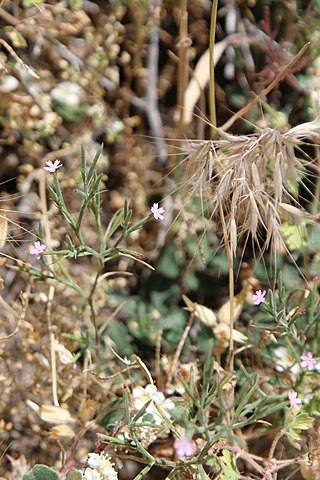
Dianthus nudiflorus, synonym Velezia rigida, is a species of flowering plant in the family Caryophyllaceae. It is native to the Mediterranean Basin countries of Europe and North Africa, and to western and central Asia and Pakistan. It is also present in northern California where it is an introduced species. It is an annual herb growing from a taproot and producing a hairy, glandular, branching green or purplish stem up to 40 centimeters tall. The linear leaves are up to 2 centimeters long. Solitary flowers occur in the leaf axils. Each flower has a very long, cylindrical, ribbed calyx of fused sepals forming the tubular throat of the flower, measuring at least a centimeter in length. At the top of the tube is the flower corolla which has five pink or purplish petals.
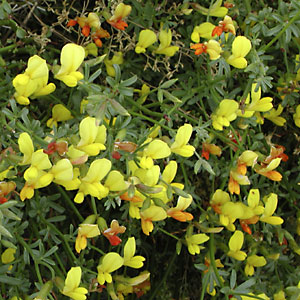
Acmispon rigidus, synonyms Lotus rigidus and Ottleya rigida, is a flowering plant in the pea family (Fabaceae), native to the southwestern United States and northwestern Mexico. It is known as shrubby deervetch or desert rock-pea. It is found in the Mojave Desert and Sonoran Desert.
Artocarpus rigidus is a tree species in the Moraceae that was described by Blume. A. rigidus is a wild species of the breadfruit/jackfruit genus (Artocarpus) and may be referred to as monkey jack. Its Vietnamese name is mít nài.

Bromus rigidus, the ripgut brome, is a grass native to Eurasia and naturalized in North America. The specific epithet rigidus means rigid or stiff.
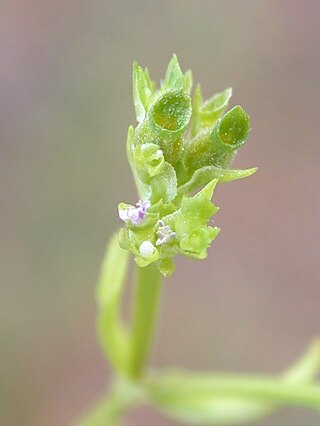
Valerianella muricata is a species of plants in the family Caprifoliaceae.


















